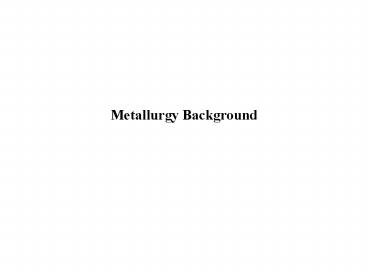Metallurgy Background - PowerPoint PPT Presentation
1 / 34
Title:
Metallurgy Background
Description:
Metallurgy Background Imperfections in Crystals Point - Vacancies & Alloys Line - Dislocations Surface - Grain Boundaries Equilibrium Arrangement of Iron Atoms in ... – PowerPoint PPT presentation
Number of Views:277
Avg rating:3.0/5.0
Title: Metallurgy Background
1
Metallurgy Background
2
Metallurgy Background
- Learning Activities
- Read Handbook pp 90-102
- Look up Keywords
- View Slides
- Read Notes,
- Listen to lecture
- View Demos
- Do on-line workbook
- Lesson Objectives
- When you finish this lesson you will understand
- Phases of mater
- Crystal Structure Crystal Defects
- Phase changes and resulting properties
- Iron Carbon Alloy System
Keywords Phase, Component, Constituent,
Solidification, Cooling Curve, Crystal Structure,
Vacancies,Substitutional Alloy, Interstitial
Alloy, Dislocations, Grain Boundaries, Allotropic
Transformation, phase diagram, ferrite, pearlite,
austenite, cementite
3
Structure of Materials
- Phases of Mater
- Crystal Structure
- Phases Changes
- Iron - Carbon Alloy System
4
Liquid
Gas
Solid
Solid
Evaporation
Sublimation
Melting
Condensation
Solidification
5
AWS Welding Handbook, 8th Ed Vol 1
6
(No Transcript)
7
(No Transcript)
8
Demonstration
Take a moment tonight to observe the
Time-Temperature Curve During Casting
Demonstration found on the Demonstration Page of
the WE300 Website.
9
AWS Welding Handbook, 8th Ed Vol 1
10
(No Transcript)
11
(No Transcript)
12
AWS Welding Handbook, 8th Ed Vol 1
13
Questions?
- Turn to the person sitting next to you and
discuss (1 min.) - Often metallurgist want to know how many atoms
are shared in any unit cell (e.g. face centered
cubic unit cell). - The atoms located on the face share ½ with one
cell and ½ with the other - How much of a corner atom is shared in each
cell? - Adding up all the partial atoms how many atoms
are there per unit cell in a face centered cubic
structure? - In a BCC structure?
14
Imperfections in Crystals
- Point - Vacancies Alloys
- Line - Dislocations
- Surface - Grain Boundaries
15
(No Transcript)
16
Edge Dislocation
Force
17
Screw Dislocation
18
Demonstration
Also take some time tonight to link to the
Dislocation-Atom interaction during deformation
Demonstration found on the Demonstration Page of
the WE300 Website
19
Grain Boundaries
Metals How to Weld Them, Lincoln Foundation,
1954
20
Questions?
- Turn to the person sitting next to you and
discuss (1 min.) - A grain boundary is the place where a crystal
with atoms all aligned in one direction meets
another crystal with atoms aligned in some other
direction with a real mismatch at the boundary.
This boundary can be thought of as a tangled mess
of dislocations. What happens when a dislocation
within one of the grains has a force applied and
it moves into the boundary tangle?
21
Equilibrium Arrangement of Iron Atoms in Pure Iron
1534 C 2795 F
(Body Centered Cubic)
Delta ferrite
1390 C 2550 F
(Face Centered Cubic)
Austenite
910 C 1670 F
Ferrite
(Body Centered Cubic)
RT
22
Cooling Curve for Pure Iron
Magnetic Transformation
Metals How to Weld Them, Lincoln Foundation,
1954
23
Alloying Elements Added to Pure Materials
Substitutional Alloy
Interstitial Alloy
24
Phase Diagram When Interstitial Carbon Alloys
with Iron
25
Metallurgical Systems
- COMPONENT
- Unit of the Composition Variable of the System
- CONSTITUENT
- Association of Phases in a Recognizably Distinct
Fashion
PHASE Homogeneous, Physically Distinct, Portion
of a System
26
Questions?
- Turn to the person sitting next to you and
discuss (1 min.) - If we take a glass of warm water and start to
dissolve sugar in it, and keep adding sugar until
no more dissolves, what happens? If we heat it a
little more what happens? - If we take warm steel in the austenite phase
(say at 1700F) and dissolve carbon in it, and
keep adding carbon until no more dissolves, what
happens? If we heat it to 2200F what happens?
27
EUTECTOID STEEL
Slow Cooling (Equilibrium) From Austenite to Just
Below the Eutectoid Temperature
28
Pearlite Growth
29
0.02C
0.8C
6.67C
X
X
X
30
(No Transcript)
31
Garbarz et al, The effect of microalloying on
microstructure and properties of medium and high
carbon ferrite-pearlite steels, Microalloying
95 Conf. Proc., 1995
32
Demonstration
Please click on the Pearlite Growth
Demonstration on the Demonstration Page of the
WE300 Website
33
Questions?
- Turn to the person sitting next to you and
discuss (1 min.) - As the pearlite forms from the very slow cooling
from the austenite, carbon atoms must diffuse to
make the lathes. What happens if we cool a
little faster thus not giving enough time for the
carbon to diffuse the complete width of the
lathes?
34
Cooling Eutectoid Steel Rapidly To Lower
Temperatures
35
Fine Pearlite
Shorter Time Lower Temp
Bainite
Martensite
36
Questions?
- Turn to the person sitting next to you and
discuss (1 min.) - In the hot water in which we added the maximum
amoount of sugar in the earlier question, we now
let it cool, what happens? - In austenite steel where we cooled it fast and
the carbon did not have a chance to get out but
rather formed a supersaturated solution, what
happens if we just let it set at room
temperature? What happens if we heat it up just
a little.

